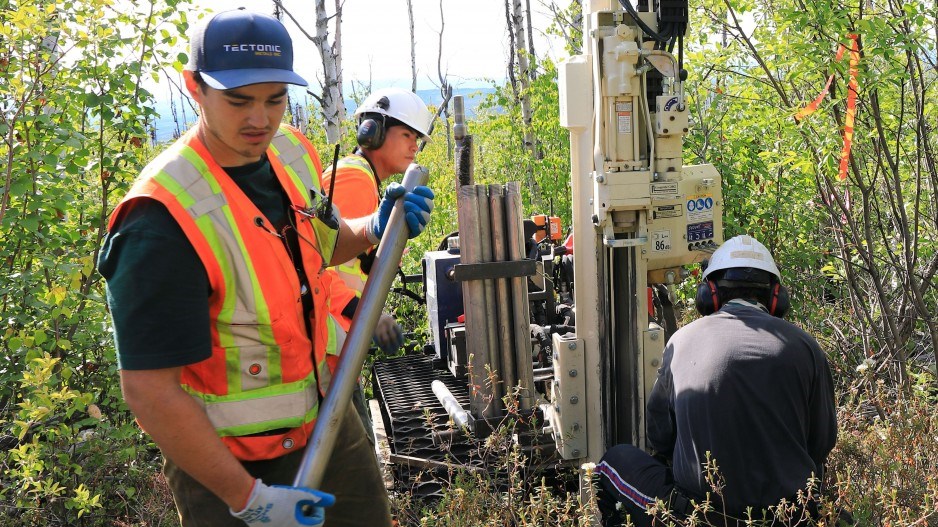After its $520 million exit in 2016, the core team that found, developed and sold the Coffee Gold project in Yukon to Goldcorp Inc. (TSX:G) took a breather, and then regrouped.
Eira Thomas, one of Kaminak Gold Corp.’s executives, took on the CEO job at one of the other companies she co-founded, Lucara Diamond (TSX:LUC) – a role she still holds.
But she and two other Kaminak executives, Robert Carpenter and Tony Reda, knew they wanted to keep working together, even though they had no particular project in mind.
“We knew we wanted to work together, so we looked at a bunch of different endeavours collectively,” said Reda, who was Kaminak’s vice-president of corporate development and is now CEO of their new company, Tectonic Metals (TSX-V:TECT).
Reda became convinced that their next project should be just across the border from Yukon, where they had developed the Coffee project.
“The three of us got together and I said, ‘We’ve got to get into Alaska,’” Reda said, “because the Yukon was becoming a crowded place, especially with the Goldcorp-Kaminak transaction.
“That political border is not a geological border. The rocks carry over. It’s completely untapped, elephant-sized deposits, seven producing mines. The Yukon at that time had zero.”
The real clincher was the regional corporations that welcome mining and own vast tracts of land as a result of the Native Claims Settlement Act in the early 1970s, which awarded 44 million acres to Alaska’s Indigenous people, known as Alaskan Natives.
“On Native-owned land, it’s fee simple land,” Reda said. “There’s limited regulatory involvement. If I want to build a road, I work directly with them.”
Typically, a new exploration company starts with a potential deposit, raises some risk capital and forms a management team. Tectonic’s founders formed the team first, and then went prospecting.
“If the team is the ultimate driver for value, why don’t we start there?” Reda reasoned.
In addition to the three core Kaminak founders, the company has brought along other former key players who worked on the Coffee project.
“We built a company around a team, around a business model,” Reda said.
Tectonic didn’t go looking just for potential gold deposits; it also went looking for partners in Alaska’s Native American-owned corporations and developed a partnership with Doyon Ltd.
With more than 12.5 million acres, Doyon is Alaska’s largest private landholder, and about two-thirds of its land is for mineral exploration. There are some 40 Alaskan tribes within the territory controlled by Doyon.
In 2018, the founders gained exclusive rights to explore and develop two projects on Doyon land – Northway and Seventymile – and one on state land. Tectonic also has rights to a third project: Tibbs, which is on state land.
“It’s a lease agreement,” Reda said. “They own the land. They’ve given us the entire rights to explore, develop and produce, and they, in exchange, get a royalty.”
Initially, the founders put about $1 million of their own money into Tectonic and then raised $11.3 million through private placements between 2018 and 2019.
They formed Tectonic Metals through a direct listing in 2019 and began listing on the TSX Venture Exchange in November.
Last month, Doyon took a $2 million, 23% stake in Tectonic, making it the company’s biggest shareholder. Doyon CEO Aaron Schutt said the Tectonic team’s successful track record in the Yukon gave Doyon confidence to take an equity position in the company.
“Their team has had success and are very highly regarded in the Canadian exploration community,” Schutt said.
“Really, what was the tipping point for us was their demonstrated work with the communities and First Nation communities in the Yukon and then their two seasons of work with our two communities in Alaska, where they interacted very well with the communities and the local tribes on the work they were doing.
“And that’s communication about what’s going on, taking input and making sure they did a good job of hiring local when they could.”
Early on, Tectonic met with villagers to determine what benefits they wanted. The company committed to local hiring and provided funding for scholarships. It also committed to developing an oral history encyclopedia to preserve the local Native language and stories. Typically, when a project gets to the stage where a feasibility study is published, it will included a number of risks and variables, including impact benefit agreements with First Nations. Tectonic wanted to address some of those uncertainties up front, so it negotiated a production agreement early on with Doyon Ltd.
“I wanted a legally binding agreement that could not be swayed or renegotiated,” Reda said.
He added that the company planned to conduct two drill programs this year.
“We have our sights on some new acquisitions as well.”




